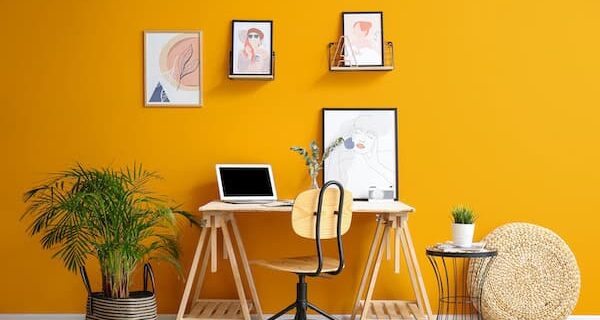Bringing Spaces To Life: Q&A On Art In The Modern Workplace

As we bring our whole selves to work, companies are finding ways to express their unique brand identity and enhance employee well-being by bringing art into the workplace.
Art in the workplace can stimulate a range of responses from creativity and curiosity to contemplation and focus. Studies have shown that art in the office can reduce stress, support well-being, foster inclusion, promote productivity, and encourage connection. Commercial design clients are increasingly bringing art into their office interiors to enrich the employee experience, support their community, demonstrate core values, and tell a brand story. Employees also expect more from their workspace and continue to share and document these spaces as extensions of themselves.
Corgan’s Art Coordination Manager, Aralyn Griesbach, helps guide clients through that process. In the following Q&A feature, she discusses her role and how bringing art into a corporate space can attract, retain, and inspire employees.
What is the impact of art in a work environment, and how does it affect design?
Griesbach: Art brings life and energy to a space. It works hand in hand with design through color, texture, scale, placement, and subject matter to create a cohesive environment. On a human scale, it makes a space feel complete, lived in, and shapes the emotional tone of a space, contributing to how people feel and behave.
It’s also a way for organizations to communicate both internally and externally. With our clients, we begin by investing in their story and history, and then we curate pieces that reflect the company’s ethos. It could be innovation, legacy, or community. Other clients want to balance hospitality with a sense of place. Art allows us to express those ideas in ways that feel personal and lasting.
How does art influence behavior and mood in the workplace? Can it shape work culture?
Griesbach: All elements of an artwork—the subject matter, the materials, and even the scale of the artwork—influence how a space feels and how people interact with it. A small, intimate piece invites a closer, slower moment. A large installation can be energizing and communal. Texture can soften a space or introduce a new layer of meaning. Larger pieces can rally employees and cultivate a culture of inclusiveness. A well-crafted visual environment can boost morale by making the space feel more engaging and authentic. Art supports psychological safety by making environments feel welcoming and personal, encouraging interaction, especially when the work is interactive, educational, or locally sourced. Investing in art and artists demonstrates a commitment to culture and connection—something employees notice and appreciate.
Workplace culture thrives in spaces that create emotional resonance. When we design for emotion through integrated art and experiential elements, we move from purely functional workplaces to places in which people want to engage.
Is placing art in the workplace a growing movement?
Griesbach: Yes, so much so that our firm has added art coordination as an in-house service. Since the pandemic—and with the rise of social media showcasing beautifully designed spaces—expectations for the workplace have shifted. People now demand more from their environments, both in aesthetics and experience. We have a different level of expectation of what we want our spaces to look and feel like. People are comparing their offices to the comfort of home, or to what they see on social media—and companies are responding.
We’re also seeing more clients treat their workplace as a destination. They want it to reflect who they are, support their teams, and feel like an experience. Art plays a significant role in making that happen.
How do you find the right pieces? How does that translate into creating a brand story?
Griesbach: It always starts with listening. Most clients don’t have a fully formed idea of what they want for their art program. We ask about who they serve, who’s coming through the space, and what values or themes they want to express. From there, we can guide them toward the right approach. Sometimes that means pulling from the company’s history or archives. Other times, we source existing works or partner with artists to create something custom. That might look like a hand-painted mural, a sculptural installation, or something digitally driven.
We’re able to offer close collaboration between art and our internal teams at Corgan—Brand+Graphics, Interiors, Lighting, and Experiential—to work together to create moments that feel layered and meaningful, and blur the line between art, brand, and design. That close collaboration across teams is one of the biggest advantages of working with Corgan. Because we’re all under one roof, we’re able to design holistically.
Are there any trends in workplace art?
Griesbach: We’re seeing murals, digital art, and experiential art with a willingness from clients to explore. We’re seeing more interactive pieces—art that changes based on movement or real-time data. We will see more of this in commercial spaces as technology and AI systems develop.
There’s also growing momentum around showcasing underrepresented voices, either local, emerging, or diverse artists whose work reflects the communities our clients serve.
As the workplace continues to evolve into more of a destination, art will play a key role in making it feel energizing, human, and personal. Art adds emotional depth and narrative, reinforcing belonging and encouraging creativity. It also grounds a space—through relatable scale, familiar materials, or the visible hand of the artist—bringing in that sense of the handmade and the human.
Contributed by Corgan

An artist from a family of artists, Griesbach’s career has spanned education, museum work, curatorial roles, and large-scale commercial art projects. She now leads Corgan’s in-house art coordination services, helping companies bring purpose and personality to their spaces through thoughtfully integrated artwork.

